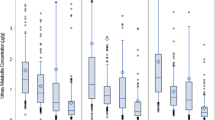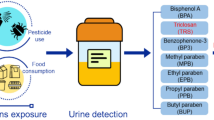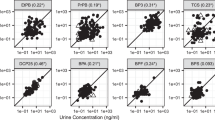Abstract
Background
Emerging studies suggest that endocrine disrupting chemicals (EDCs) in personal care and other consumer products are linked with various adverse health effects, including respiratory and reproductive effects. Despite Black persons using more personal care products than other demographic groups and having a high asthma burden, little is known regarding their consumer product use patterns and associated EDC exposures.
Objective
To examine the association between recent exposure to select EDCs with specific consumer products and behaviors in a cohort of 110 predominantly Black children with asthma, ages 8–17 years, living in Baltimore City, Maryland.
Methods
We quantified concentrations of bisphenol A (BPA), bisphenol S (BPS), bisphenol F, two dichlorophenols, four parabens, triclosan, benzophenone-3, and triclocarban in spot urine samples. Questionnaires were used to capture recent (last 24-h) consumer product use and behaviors. Associations between EDCs and consumer product uses/behaviors were assessed using multivariable linear regression, adjusting for age, gender, race/ethnicity, and caregiver income level. Effect estimates were expressed as geometric mean ratios of biomarker concentrations of product-users vs non-users.
Results
Increased concentrations to select EDCs were associated with recent use of air freshener (ratios; BPA: 1.9, 95%CI 1.4–2; BPS 1.7, 95%CI 1–2.97; propyl paraben: 3.0, 95%CI 1.6–5.6), scented candles (methyl paraben: 2.6, 95%CI 1.1–6.1), and scented carpet powder (2,5-dichlorophenol: 2.8, 95%CI 1.2–6.3). Additionally, consuming canned food was associated with some increased biomarker concentrations (ratios: BPA: 1.7, 95%CI 1.2–2.4; BPS: 2.1, 95% CI: 1.2–3.6).
Significance
These findings add to the body of evidence suggesting that recent use of select consumer products in Black children contributes to exposure of chemicals of concern and could potentially inform exposure mitigation interventions. Findings have broad potential health implications for pediatric populations and Black children who may face exposure and health disparities.
Impact
-
Little is known about how children’s personal care product use and consumer behaviors affect their exposures to endocrine disrupting chemicals (EDCs). This is particularly true for Black children who often experience a disparate exposure burden to many EDCs. This is a significant knowledge gap among children that are uniquely vulnerable to EDCs as they undergo critical windows of growth and development. Our findings show associations between consumer products and EDC exposures in predominantly Black children in low-income settings. Identifying EDC exposure determinants has broad health implications as many of these chemicals have been associated with adverse health risks.
This is a preview of subscription content, access via your institution
Access options
Subscribe to this journal
Receive 6 print issues and online access
$259.00 per year
only $43.17 per issue
Buy this article
- Purchase on SpringerLink
- Instant access to full article PDF
Prices may be subject to local taxes which are calculated during checkout



Similar content being viewed by others
Data availability
The datasets generated during and/or analyzed during the current study are not publicly available due to participant confidentiality but are available from the corresponding author on reasonable request.
References
Centers for Disease Control and Prevention. National Report on Human Exposure to Environmental Chemicals. 2009. https://www.cdc.gov/exposurereport/index.html (accessed 24 May2021).
Metcalfe CD, Bayen S, Desrosiers M, Muñoz G, Sauvé S, Yargeau V. An introduction to the sources, fate, occurrence and effects of endocrine disrupting chemicals released into the environment. Environ Res. 2022;207:112658.
Sly PD, Flack F. Susceptibility of children to environmental pollutants. Ann N Y Acad Sci. 2008;1140:163–83.
Raley E, Quiros-Alcala L, Matsui EC. Chemical exposures via personal care products and the disproportionate asthma burden among the US Black population. J Allergy Clin Immunol Pract. 2021;9:3290–2.
Rochester JR. Bisphenol A and human health: a review of the literature. Reprod Toxicol. 2013;42:132–55.
Kahn LG, Philippat C, Nakayama SF, Slama R, Trasande L. Endocrine-disrupting chemicals: implications for human health. Lancet Diabetes Endocrinol. 2020;8:703–18.
Quirós-Alcalá L, Hansel NN, McCormack M, Calafat AM, Ye X, Peng RD, et al. Exposure to bisphenols and asthma morbidity among low-income urban children with asthma. J Allergy Clin Immunol. 2021;147:577–86.
Chalubinski M, Kowalski ML. Endocrine disrupters—potential modulators of the immune system and allergic response. Allergy. 2006;61:1326–35.
Kuo C-H, Yang S-N, Kuo P-L, Hung C-H. Immunomodulatory effects of environmental endocrine disrupting chemicals. Kaohsiung J Med Sci. 2012;28:S37–S42.
Yang S-N, Hsieh C-C, Kuo H-F, Lee M-S, Huang M-Y, Kuo C-H, et al. The effects of environmental toxins on allergic inflammation. Allergy Asthma Immunol Res. 2014;6:478–84.
Collins HN, Johnson PI, Calderon NM, Clark PY, Gillis AD, Le AM, et al. Differences in personal care product use by race/ethnicity among women in California: implications for chemical exposures. J Expo Sci Environ Epidemiol. 2023;33:292–300.
James-Todd T, Meeker J, Huang T, Hauser R, Seely E, Ferguson K, et al. Racial and ethnic variations in phthalate metabolite concentrations across pregnancy. J Expo Sci Environ Epidemiol. 2017;27:160–6.
Ruiz D, Becerra M, Jagai JS, Ard K, Sargis RM. Disparities in environmental exposures to endocrine-disrupting chemicals and diabetes risk in vulnerable populations. Diabetes Care. 2018;41:193–205.
van Woerden I, Bruening M, Montresor-López J, Payne-Sturges DC. Trends and disparities in urinary BPA concentrations among U.S. emerging adults. Environ Res. 2019;176:108515.
Nielsen. Resilient, Receptive and Relevant. 2013. https://www.nielsen.com/insights/2013/resilient-receptive-and-relevant/ (accessed 17 May2021).
Gaston SA, James-Todd T, Harmon Q, Taylor KW, Baird D, Jackson CL. Chemical/straightening and other hair product usage during childhood, adolescence, and adulthood among African-American women: potential implications for health. J Expo Sci Environ Epidemiol. 2020;30:86–96.
Berger KP, Kogut KR, Bradman A, She J, Gavin Q, Zahedi R, et al. Personal care product use as a predictor of urinary concentrations of certain phthalates, parabens, and phenols in the HERMOSA study. J Expo Sci Environ Epidemiol. 2019;29:21–32.
Dodson RE, Boronow KE, Susmann H, Udesky JO, Rodgers KM, Weller D, et al. Consumer behavior and exposure to parabens, bisphenols, triclosan, dichlorophenols, and benzophenone-3: results from a crowdsourced biomonitoring study. Int J Hyg Environ Health. 2020;230:113624.
Fisher M, MacPherson S, Braun JM, Hauser R, Walker M, Feeley M, et al. Paraben concentrations in maternal urine and breast milk and its association with personal care product use. Environ Sci Technol. 2017;51:4009–17.
Philippat C, Bennett D, Calafat AM, Picciotto IH. Exposure to select phthalates and phenols through use of personal care products among Californian adults and their children. Environ Res. 2015;140:369–76.
Yilmaz B, Terekeci H, Sandal S, Kelestimur F. Endocrine disrupting chemicals: exposure, effects on human health, mechanism of action, models for testing and strategies for prevention. Rev Endocr Metab Disord. 2020;21:127–47.
ClinicalTrials.gov, Johns Hopkins University. AIRWEIGHS: Investigating Obesity as a Susceptibility Factor for Air Pollution in Childhood Asthma. 2022. https://clinicaltrials.gov/ct2/show/NCT02763917 (accessed 5 Jun2023).
Kaviany P, Brigham EP, Collaco JM, Rice JL, Woo H, Wood M, et al. Patterns and predictors of air purifier adherence in children with asthma living in low-income, urban households. J Asthma J Assoc Care Asthma. 2022;59:946–55.
Busse WW, Boushey HA, Camargo CA, Evans D, Foggs MB, Platts-Mills TAE, et al. National Asthma Education and Prevention Program, Third Expert Panel on the Diagnosis and Management of Asthma. Expert Panel Report 3: Guidelines for the Diagnosis and Management of Asthma. Bethesda (MD): National Heart, Lung, and Blood Institute (US); 2007 Aug. Available from: https://www.ncbi.nlm.nih.gov/books/NBK7232/.
Gonzalez H, Farbrot A, Larkö O, Wennberg A. Percutaneous absorption of the sunscreen benzophenone‐3 after repeated whole‐body applications, with and without ultraviolet irradiation. Br J Dermatol. 2006;154:337–40.
Janjua NR, Frederiksen H, Skakkebæk NE, Wulf HC, Andersson A-M. Urinary excretion of phthalates and paraben after repeated whole-body topical application in humans. Int J Androl. 2008;31:118–30.
Sandborgh-Englund G, Adolfsson-Erici M, Odham G, Ekstrand J. Pharmacokinetics of triclosan following oral ingestion in humans. J Toxicol Environ Health A. 2006;69:1861–73.
Colgate-Palmolive Company. Our Policy on Ingredient Safety | Colgate-Palmolive. 2023. https://www.colgatepalmolive.com/en-us/sustainability/our-sustainability-policies/ingredient-safety (accessed 24 Nov2023).
Ye X, Kuklenyik Z, Needham LL, Calafat AM. Automated on-line column-switching HPLC-MS/MS method with peak focusing for the determination of nine environmental phenols in urine. Anal Chem. 2005;77:5407–13.
Caudill SP, Schleicher RL, Pirkle JL. Multi-rule quality control for the age-related eye disease study. Stat Med. 2008;27:4094–106.
Guo Y, Kannan K. A survey of phthalates and parabens in personal care products from the United States and its implications for human exposure. Environ Sci Technol. 2013;47:14442–9.
Soni MG, Taylor SL, Greenberg NA, Burdock GA. Evaluation of the health aspects of methyl paraben: a review of the published literature. Food Chem Toxicol. 2002;40:1335–73.
Soni MG, Burdock GA, Taylor SL, Greenberg NA. Safety assessment of propyl paraben: a review of the published literature. Food Chem Toxicol. 2001;39:513–32.
Rastogi SC. UV filters in sunscreen products—a survey. Contact Dermat. 2002;46:348–51.
Centers for Disease Control and Prevention. Biomonitoring Summary 2,5-Dichlorophenol. 2017. https://www.cdc.gov/biomonitoring/25D_BiomonitoringSummary.html (accessed 14 Aug2023).
Boeniger MF, Lowry LK, Rosenberg J. Interpretation of urine results used to assess chemical exposure with emphasis on creatinine adjustments: a review. Am Ind Hyg Assoc J. 1993;54:615–27.
Lubin JH, Colt JS, Camann D, Davis S, Cerhan JR, Severson RK, et al. Epidemiologic evaluation of measurement data in the presence of detection limits. Environ Health Perspect. 2004;112:1691–6.
Clark AAS, May, R, Donatello, VA Practical Multivariate Analysis. 6th ed. Boca Raton: Chapman and Hall/CRC; 2019. https://doi.org/10.1201/9781315203737.
Hosmer DW Jr, Lemeshow S. Applied Logistic Regression. John Wiley & Sons; 2004.
Quirós-Alcalá L, Buckley JP, Boyle M. Parabens and measures of adiposity among adults and children from the U.S. general population: NHANES 2007-2014. Int J Hyg Environ Health. 2018;221:652–60.
Vindenes HK, Svanes C, Lygre SHL, Real FG, Ringel-Kulka T, Bertelsen RJ. Exposure to environmental phenols and parabens, and relation to body mass index, eczema and respiratory outcomes in the Norwegian RHINESSA study. Environ Health. 2021;20:81.
Althouse AD. Adjust for multiple comparisons? It’s not that simple. Ann Thorac Surg. 2016;101:1644–5.
Rothman KJ. No adjustments are needed for multiple comparisons. Epidemiology. 1990;1:43–6.
Centers for Disease Control and Prevention, National Center for Health Statistics. 2015-2016 Laboratory Data - Continuous NHANES. 2019. https://wwwn.cdc.gov/nchs/nhanes/search/datapage.aspx?Component=Laboratory&Cycle=2015-2016 (accessed 4 Aug2023).
Food and Drug Administration, HHS. Safety and effectiveness of consumer antiseptics; topical antimicrobial drug products for over-the-counter human use. Final rule. Fed Regist. 2016;81:61106–30.
Weatherly LM, Gosse JA. Triclosan exposure, transformation, and human health effects. J Toxicol Environ Health B Crit Rev. 2017;20:447–69.
National Institutes of Health-NIH National Library of Medicine- NLM. Household products database. Househ Prod Database. 2006. http://householdproducts.nlm.nih.gov/ (accessed 12 Jul2023).
Panico A, Serio F, Bagordo F, Grassi T, Idolo A, Giorgi MD, et al. Skin safety and health prevention: an overview of chemicals in cosmetic products. J Prev Med Hyg. 2019;60:E50–E50.
Liao C, Kannan K. Widespread occurrence of benzophenone-type UV light filters in personal care products from China and the United States: an assessment of human exposure. Environ Sci Technol. 2014;48:4103–9.
Ferguson KK, Colacino JA, Lewis RC, Meeker JD. Personal care product use among adults in NHANES: associations between urinary phthalate metabolites and phenols and use of mouthwash and sunscreen. J Expo Sci Environ Epidemiol. 2017;27:326–32.
Zamoiski RD, Cahoon EK, Michal Freedman D, Linet MS. Self-reported sunscreen use and urinary benzophenone-3 concentrations in the United States: NHANES 2003-2006 and 2009-2012. Environ Res. 2015;142:563–7.
Calafat AM, Ye X, Wong L-Y, Bishop AM, Needham LL. Urinary concentrations of four parabens in the U.S. Population: NHANES 2005–2006. Environ Health Perspect. 2010;118:679–85.
Charla R, Collier D, Johnson M, Meier B, Binder A, May K. Phthalate exposure in children: assessing knowledge, attitudes, and behaviors in families with low socioeconomic status. Int Public Health J. 2022;14:251–61.
Bridges B. Fragrance: emerging health and environmental concerns. Flavour Fragr J. 2002;17:361–71.
Darbre PD, Harvey PW. Paraben esters: review of recent studies of endocrine toxicity, absorption, esterase and human exposure, and discussion of potential human health risks. J Appl Toxicol. 2008;28:561–78.
Quirόs-Alcalá L, Hansel NN, McCormack MC, Matsui EC. Paraben exposures and asthma-related outcomes among children from the US general population. J Allergy Clin Immunol. 2019;143:948–56.e4.
Steinemann A, Goodman N. Fragranced consumer products and effects on asthmatics: an international population-based study. Air Qual Atmos Health. 2019;12:643–9.
Berger K, Eskenazi B, Balmes J, Kogut K, Holland N, Calafat AM, et al. Prenatal high molecular weight phthalates and bisphenol A, and childhood respiratory and allergic outcomes. Pediatr Allergy Immunol. 2019;30:36–46.
Centers for Disease Control and Prevention. Biomonitoring Summary 2,4-Dichlorophenol. 2017. https://www.cdc.gov/biomonitoring/24D_BiomonitoringSummary.html (accessed 14 Aug2023).
Zhu L, Hajeb P, Fauser P, Vorkamp K. Endocrine disrupting chemicals in indoor dust: a review of temporal and spatial trends, and human exposure. Sci Total Environ. 2023;874:162374.
Dodson RE, Cardona B, Zota AR, Robinson Flint J, Navarro S, Shamasunder B. Personal care product use among diverse women in California: Taking Stock Study. J Expo Sci Environ Epidemiol. 2021;31:487–502.
Chen D, Kannan K, Tan H, Zheng Z, Feng Y-L, Wu Y, et al. Bisphenol analogues other than BPA: environmental occurrence, human exposure, and toxicity—a review. Environ Sci Technol. 2016;50:5438–53.
Geens T, Aerts D, Berthot C, Bourguignon J-P, Goeyens L, Lecomte P, et al. A review of dietary and non-dietary exposure to bisphenol-A. Food Chem Toxicol Int J Publ Br Ind Biol Res Assoc. 2012;50:3725–40.
Hartle JC, Navas-Acien A, Lawrence RS. The consumption of canned food and beverages and urinary Bisphenol A concentrations in NHANES 2003–2008. Environ Res. 2016;150:375–82.
Peng C-Y, Tsai E-M, Kao T-H, Lai T-C, Liang S-S, Chiu C-C, et al. Canned food intake and urinary bisphenol a concentrations: a randomized crossover intervention study. Environ Sci Pollut Res. 2019;26:27999–8009.
Akhbarizadeh R, Dobaradaran S, Schmidt TC, Nabipour I, Spitz J. Worldwide bottled water occurrence of emerging contaminants: a review of the recent scientific literature. J Hazard Mater. 2020;392:122271.
Arnold SM, Clark KE, Staples CA, Klecka GM, Dimond SS, Caspers N, et al. Relevance of drinking water as a source of human exposure to bisphenol A. J Expo Sci Environ Epidemiol. 2013;23:137–44.
Ji Z, Liu J, Sakkiah S, Guo W, Hong H. BPA replacement compounds: current status and perspectives. ACS Sustain Chem Eng. 2021;9:2433–46.
Cohen JFW, Richardson S, March WW, Gosliner W, Hauser R. Phthalates, adipates, BPA, and pesticides in school meals. Environ Res. 2023;236:116632.
Hartle JC, Fox MA, Lawrence RS. Probabilistic modeling of school meals for potential bisphenol A (BPA) exposure. J Expo Sci Environ Epidemiol. 2016;26:315–23.
Larson NI, Story MT, Nelson MC. Neighborhood environments: disparities in access to healthy foods in the U.S. Am J Prev Med. 2009;36:74–81.e10.
Dodson RE, Nishioka M, Standley LJ, Perovich LJ, Brody JG, Rudel RA. Endocrine disruptors and asthma-associated chemicals in consumer products. Environ Health Perspect. 2012;120:935–43.
Johnson PI, Favela K, Jarin J, Le AM, Clark PY, Fu L, et al. Chemicals of concern in personal care products used by women of color in three communities of California. J Expo Sci Environ Epidemiol. 2022;32:864–76.
Fandiño-Del-Rio M, Matsui EC, Peng RD, Meeker JD, Quirós-Alcalá L. Phthalate biomarkers and associations with respiratory symptoms and healthcare utilization among low-income urban children with asthma. Environ Res. 2022;212:113239.
Acknowledgements
We gratefully acknowledge all the funders, the staff and study participants who made this study possible.
Funding
This work was supported by the National Institute of Environmental Health Sciences (NIEHS) of the National Institutes of Health under grant number P50ES018176 and under award numbers P2CES033415, U2CES026553; L.Q.A. and M.F. were supported by a National Heart, Lung, and Blood Institute Career Development Award (K01HL138124).
Author information
Authors and Affiliations
Contributions
Magdalena Fandiño-Del-Rio: writing - original draft, visualization, formal analysis, data curation; Elizabeth C. Matsui: conceptualization, methodology, supervision, funding acquisition, writing - review & editing; Antonia M. Calafat: investigation, resources, data curation, writing - review & editing; Rachelle Koehl: investigation, supervision, data curation, writing - review & editing; Julianne Cook Botelho: investigation, writing - review & editing; Han Woo: investigation, supervision, data curation, writing - review & editing; Meleah Boyle: investigation, writing - review & editing; Nadia N. Hansel: conceptualization, investigation, supervision, writing - review & editing; Meredith McCormack: conceptualization, methodology, investigation, supervision, project administration, funding acquisition, writing - review & editing; Lesliam Quirós-Alcalá: conceptualization, methodology, investigation, supervision, project administration, funding acquisition, writing - review & editing.
Corresponding author
Ethics declarations
Competing interests
The authors declare no competing interests.
Ethical approval
All study protocols were approved by the Johns Hopkins University Institutional Review Board and written informed consent and assent was obtained from parents and participating children, respectively, prior to any data and sample collection. The analysis of de-identified specimens at the Centers for Disease Control and Prevention (CDC) laboratory was determined not to constitute engagement in human subjects research by CDC.
Additional information
Publisher’s note Springer Nature remains neutral with regard to jurisdictional claims in published maps and institutional affiliations.
Supplementary information
Rights and permissions
Springer Nature or its licensor (e.g. a society or other partner) holds exclusive rights to this article under a publishing agreement with the author(s) or other rightsholder(s); author self-archiving of the accepted manuscript version of this article is solely governed by the terms of such publishing agreement and applicable law.
About this article
Cite this article
Fandiño-Del-Rio, M., Matsui, E.C., Calafat, A.M. et al. Recent use of consumer and personal care products and exposures to select endocrine disrupting chemicals among urban children with asthma. J Expo Sci Environ Epidemiol 34, 637–646 (2024). https://doi.org/10.1038/s41370-024-00693-8
Received:
Revised:
Accepted:
Published:
Issue date:
DOI: https://doi.org/10.1038/s41370-024-00693-8



